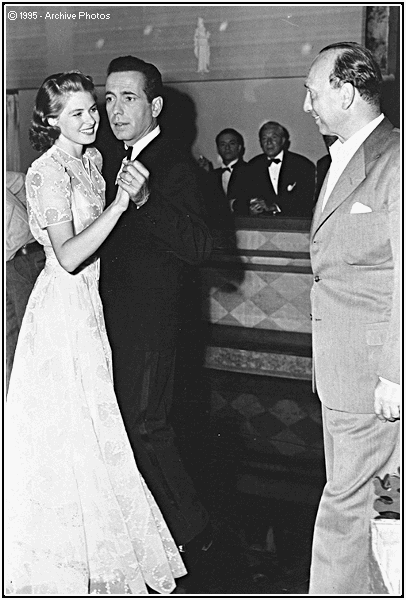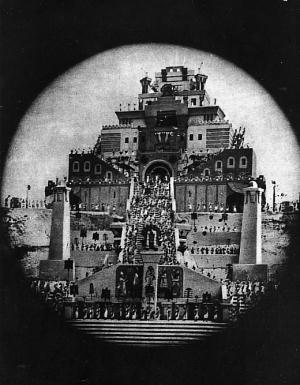MICHAEL CURTIZ



Michael Curtiz directing Humphrey Bogart and Ingrid Bergman on the set of Casablanca
Why this site?
Though movies like The Kennel Murder Case, Mystery of the Wax Museum, The Charge of the Light Brigade, The Adventures of Robin Hood, Yankee Doodle Dandy, Casablanca & Mildred Pierce are considered genre-masterpieces, Curtiz is rarely seen as the auteur of these films because on the surface they are so radically different that it is difficult to see a connection. Also the sheer bulk of his output has made it difficult for filmcritics to label him as an auteur. It is my opinion though that by looking at his best work you can certainly find a distinct signature;stylisticly but also thematicly. Therefore the dismissal of Curtiz as merely a likeable craftsman(Andrew Sarris), does not do him justice. I recognise the fortunate position he was in working for the Warner Brothers Studios in the 30's and 40's,with people like Anton Grot,Sol Polito, George Amy, Max Steiner,& Erich Wolfgang Korngold. Little is known about this Hungarian born director. Reports about his life tend to contradict. This site is put up to share and gather information from the web about my favourite director.
FEATURED ATTRACTIONS

THE LIST OF MOVIES
Eye-candy
QUOTES
some funny and interesting quotes and of course "curtizisms"
TRIVIA
The Curtiz guest-house
RELATED LINKS PAGE

A perfect way to understand why this director doesn't get the credit he deserves is to read this bookreview:
THE CASABLANCA MAN: THE CINEMA OF MICHAEL CURTIZ
By James C. Robertson. New York: Routledge, 1995. 202 pp.
Author James C. Robertson describes himself as "an incurable but inexpert
film fan." In his book he seeks--thanks to a grant from the British
Film Academy that allowed him to study the Warner Brothers Archive-
-to set the record straight on Michael Curtiz, whose films have given
him great pleasure for many decades. In Robertson's opinion, the view
that Curtiz was a "studio hack"--or, at best, a skilled technician
who owed the visual quality of his films to his art directors and
camera-men-is unmerited. In contrast, Robertson argues,Curtiz was
undeniably the top director at Warners during the classic studio period.
He was a master of many genres, whose "distinguished record of high-
quality versatility in depth . . . no other Hollywood director can
even approach."
Of necessity, because information is skimpy, Robertson devotes only
three paragraphs to Curtiz's early career in Hungary. There are only
five more about his days in Vienna, which brought him to the attention
of Jack and Harry Warner--probably because Robertson primarily wants
to discuss the films that most of us have seen. Nine pages are devoted
to Curtiz's silent films and those in which he made the transition
to sound.  Chapter 3 examines the director's output (1930-35) as he
expanded his repertoire of genres: musicals, horror films (Dr. X and
The Mystery of the Wax Museum,The Walking Dead), detective dramas (The Kennel Murder
Case), social protest (20,000 Years in Sing Sing and Black Fury),
and adventure/spectacle (Captain Blood). Although their variability
depended on the assignments, the films of the late thirties form an
impressive list of crowd-pleasing entertainments: The Charge of the
Light Brigade, Kid Galahad, The Adventures of Robin Hood, Four Daughters,
Angels with DirtyFaces, Dodge City, The Sea Hawk, and The Sea Wolf
Robertson always takes care to remind readers of the box-office earnings
of these popular movies; and to Curtiz's advantage, his record is
compared, artistically and commercially, to that of his onetime colleague
at Warners, Mervyn LeRoy.
Chapter 3 examines the director's output (1930-35) as he
expanded his repertoire of genres: musicals, horror films (Dr. X and
The Mystery of the Wax Museum,The Walking Dead), detective dramas (The Kennel Murder
Case), social protest (20,000 Years in Sing Sing and Black Fury),
and adventure/spectacle (Captain Blood). Although their variability
depended on the assignments, the films of the late thirties form an
impressive list of crowd-pleasing entertainments: The Charge of the
Light Brigade, Kid Galahad, The Adventures of Robin Hood, Four Daughters,
Angels with DirtyFaces, Dodge City, The Sea Hawk, and The Sea Wolf
Robertson always takes care to remind readers of the box-office earnings
of these popular movies; and to Curtiz's advantage, his record is
compared, artistically and commercially, to that of his onetime colleague
at Warners, Mervyn LeRoy.
In the forties, there was more of the same, with Janie and the like
following Yankee Doodle Dandy and Casablanca. Curtiz is said to have
seen the potential of Mildred Pierce as a film noir, as if he also
anticipated the coining of the term: In keeping with his reputation
for versatility, Curtiz directed some dire projects (Night and Day)
and some prestigious ones (Mission to Moscow and Life With Father).
I would agree with the author that Curtiz's masterpiece is The Breaking
Point (1950). "Far and away the most successful serious attempt to
bring the spirit of Hemingway to the screen," this version of To Have
and Have Not stands in stark contrast to the Howard Hawks film of
that title, which relates in no way to Hemingway's novel. The film
displays Curtiz's gift for drawing superior performances from actors:
John Garfield, Patricia Neal, Phyllis Thaxter, and Juano Hernandez
were never better. I wonder, as Robertson does, why it is not available
for viewing. (It is not on video cassette, and television stations
do not schedule it.)
Robertson devotes a brief chapter to Curtiz's later career, after
he left Warner Brothers. The move was assessed by Andrew Sarris in
American Cinema as a demonstration of artistic decline when studio
discipline was lacking. Robertson disagrees, arguing that White Christmas
is "very good light entertainment" and that The Egyptian for "sheer
spectacle" represents Curtiz at his best. Some readers may share my
opinion that the first is unwatch-able and the second is ponderous
and dull. Curtiz also took on several doomed projects, such as The
Vagabond King with Oreste. However, Robertson makes a case for reassessments
of King Creole, The Proud Rebel, and The Best Things in Life Are Free,
although he does not convince me that virtues can be found in The
Helen Morgan Story. Because Robertson is concerned almost entirely
with Curtiz's public career, he intimates, surprisingly, that Cur-
tiz may have become involved in several woeful films because he needed
money to support the illegitimate children he allegedly fathered.
Hardly ever is what we see on the screen related to his private life.
To establish Curtiz as an auteur is difficult, but he had the ability, as in Casablanca, "to weld player, writers, and technicians into a strong team." Like John Ford, Curtiz thought that a film should be cut in the camera, and like Billy Wilder he understood that a first- rate film cannot be made without a first-rate script.
The truth probably
liessomewhere between the dismissal of Curtiz as a superb technician,
who subordinated his talents to the studio machine, and Robertson'
s somewhat idolatrous view that Curtiz's "large-scale versatility
is unique in cinema history and unlikely ever to be rivaled, much
less surpassed."; For the author, the frequency of showings of Curtiz'
s films on television is an enduring tribute to the director's talent.
In any case, Robertson's book concisely re-opens the debate about
Curtiz's contributions to cinema.
By James Van Dyck Card, Old Dominion University
Van Dyck Card, James, Book reviews.., Vol. 24, Journal of Popular Film & Television, 04-01-1996, pp 45.
or if you have any comments,suggestions or questions write to me ps.I lost my password to this siteand just recovered it; so any mails sent the last 5 YEARS! please resend and I'll respond , NEW UPDATED EMAIL ADRESS (15 june 2012):
|
|
|
